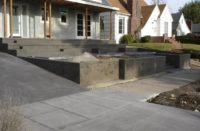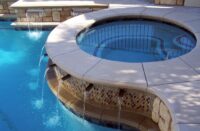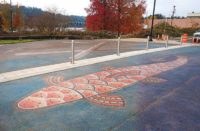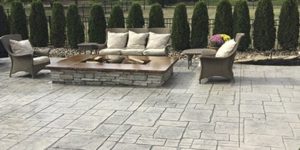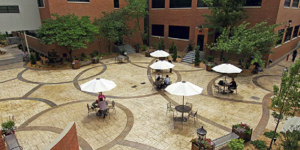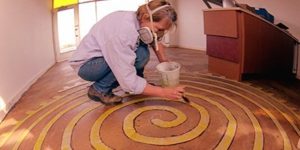
Throughout the United States and Canada, even in cold climates, homeowners are clamoring for outdoor kitchens and living spaces to enhance the beauty, comfort and resale value of their homes.
Imagine if you could offer a stunning fire feature that defines your clients’ outdoor living experience. The attraction of fire is undeniable. Take advantage of this attraction to create distinctive fire pits that will pay off in big ways for both you and your clients. Your work will take center stage in your client’s outdoor living space.
In this article, I will give an overview of the background knowledge you need to understand fire features. I’ll cover fuel types, the hardware, the fire media, design considerations and safety. Once you understand these issues, you can let your creativity take over.
Safety first
There are many design considerations when creating fire features. First and foremost is safety. In each of the sections below, I touch on safety. Fire is dangerous, which, in effect makes your product dangerous. Before embarking on any fire feature project, I strongly recommend reading the safety information in the book “Outdoor Fireplaces & Fire Pits,” by Scott Cohen, owner of The Green Scene Landscaping and Pools, and check your local regulations.

Fuel types
Fire features can be fueled by wood, propane gas, natural gas or alcohol. Each of these fuel types has its pros and cons.
Wood, while burning, must not come directly into contact with the concrete. The extreme thermal stress will cause expansion, cracking, spalling and chemical degradation.
Refractory concrete is resistant to very high temperatures, and that’s why it’s used to line pizza ovens and boilers. However, refractory concrete should never be used in an open fire pit where it can get wet from rain or snow. The steam generated from heating wet refractory concrete can cause cracking and spalling. Instead, line the firebox with fire brick or metal, and insulate the concrete from the fire box with at least a 4-inch air gap or 2 inches of crushed lava rock.

Propane is a type of liquefied petroleum gas that is denser than air, so unignited gas vapors will pool in confined spaces. This presents an explosion hazard. Always properly vent a propane-fueled fire pit! The venting must be near ground level, with a minimum 18 square inches of free area per vent, set no more than 5 inches above ground level. There must be at least two vent holes 180 inches apart for adequate cross-ventilation.Be aware that wood burning may be illegal in your area or only allowed certain times of the year. Wood fires are also more unpredictable than the other types of fuel, with the potential for sparking. Provide a spark screen with a wood-burning fire feature. Last but not least, wood fires do not turn off instantly, so safe, responsible burning is a prime concern.
Fire glass should be no deeper than 1/4 inch above the top of the burner for optimum flame and minimum back-pressure. Large lava rock (2 inches or larger in size) may be up to 3 inches deep above the top of the burner. Do not exceed the 1/4-inch depth with fire glass or small lava rock directly above burner holes. Applying too much glass or small rock may result in unburned gas pooling in the fire pit and exploding.
Propane should be mixed with air by use of a pressure regulator and an air-fuel mixer. Not using air will result in a very sooty flame. Mixing in air makes the flame burn cleaner, but with or without, propane tends to make fire glass sooty, so a light color of glass will not retain its look for long.
Propane fire features are not meant for cooking and do not produce a high-heat flame that would burn clean and appear blue. Decorative propane fire features instead produce a cooler flame that is more yellow in color and more closely resembles a wood fire.
Natural gas is cleaner burning and does not deposit soot on the fire media. Compressed natural gas is lighter than air, so it will not pool and does not require ventilation. Natural gas is also about one third the cost of propane. However, natural gas must be hard-plumbed by a licensed contractor. And fire glass or lava rock should be no deeper than 3 inches above the top of the burner for optimum flame and minimum back-pressure.
Coarse gravel or lava rock may be used under the burner as support. Coarse materials drain well and don’t hold much moisture. Sand should not be used because it holds large amounts of moisture and does not vent well.
Alcohol fuels are placed in stainless steel, drop-in units. There are many types of alcohol-based fuels, including ethanol, denatured alcohol, spirits, biofuel, bioethanol, fireplace fuel, and fire gel. These fuels can be used indoors or outdoors and require no venting. However, small, alcohol-based fire features could be knocked over. And alcohol is an extremely expensive fuel that does not develop a very large flame. This type of fire feature is more like a big candle. Depending on the design, they can still be very dramatic.
Hardware
The next thing to understand about fire features is the hardware: igniter, burners or rings, burner pans, air mixers, piping and valves.
Fire pits may be ignited manually with a match, with a push-button spark igniter (like a gas grill), or with an automatic igniter.
If an automatic igniter is used, the ignition source is wired to the burner, with the ignition switch being some distance away from the fire feature. Timers and remote controllers are also available. These items can be quite costly.
Additionally, a flame sensor may be installed, which contains a thermocouple safety switch that shuts off the gas if the flame goes out. These are often required on commercial installations.
There are many different sizes and shapes of fire burners for propane and natural gas. Many are circular rings, some are linear, and some are star-shaped to provide even flame distribution. Better-quality burners are made from stainless steel.
The burner is placed on a stainless steel pan that supports the burner and the fire glass or rock. The igniter also mounts to the pan.
Piping connects the fire burner to a valve. The valve may be a key valve or a ball valve. Key valves are required by law in some areas, and are necessary on a hard-plumbed installation with an essentially infinite source of fuel.
Safety considerations
For safety, there must be some way to turn off and prohibit use of the fuel. With a propane tank, this is easily achieved simply by using the quick disconnect to disconnect the propane tank and remove it. For hard-plumbed installations, a key valve lets you turn off the fuel and lock it off by taking away the key.
Scott Cohen strongly recommends a manual key valve and match lighting rather than an automatic igniter. This allows the holder of the key to evaluate current weather conditions and adjust the height of the fire accordingly. It also clearly puts responsibility for fire safety on the person holding the key.

Fire media
Fire media can be an exciting part of the design of a fire feature. There are many colors, shapes and sizes available. Materials are fire glass, lava rock and ceramic.
Do not use stone, regular glass, gravel, rocks, nonrefractory ceramic or other materials in direct contact with open flames. These materials could shatter or explode when heated by flame.
Basic design considerations
Aside from the general aesthetics, the design of a fire pit plays a significant role in its safety, durability and reliability.
Fire pits (except for small alcohol burners) should only ever be used and installed outdoors. Drainage is an important consideration, not only to eliminate stagnant water from pooling inside the fire pit, but also to keep metal parts in good working order for a longer time.
Solid metal covers help keep fire media clean and dry, eliminating debris from collecting on and potentially clogging the burner.
Covers also help protect bystanders from hot glass media once the fire pit is shut off. Fire media can stay dangerously hot for a long time after the flames are gone. A cover can prevent accidental contact that could cause serious burns, as hot fire media still looks the same as it does when it is cold. Some fire glass is colorful and shaped like jelly beans, and children may be tempted to pick it up.
Mesh covers act as spark arrestors and are needed only for wood-fueled fire pits. These may be required by law in some areas.

Burner depth
Good fire-pit designs place the fire burner high in the fire pit, with very little concrete exposed to the heat from the fire. Not only does this allow for greater flame exposure above the fire pit, but it also minimizes the amount of concrete that is heated by the flames.
Concrete won’t burn, but intense heating can cause cracking, spalling and even chemical degradation. This is why concrete should never be directly exposed to open flame or burning embers. Even indirect heating from nearby flames can cause thermal expansion and cracking, which is why well-designed fire pots keep the concrete far from the flames and expose very little concrete to the radiated heat.
There’s another good reason to minimize the amount of concrete that gets hot: safety. Like fire media, hot concrete looks the same as cold concrete, so the best rule of thumb for safety and long-term durability is to keep the concrete cool to the touch.
Now that you understand how the various parts of fire features work and the important safety and design considerations, you can expand your outdoor custom concrete repertoire beyond flooring surfaces and simple barbecue tops and offer your clients an all-around “wow” experience with custom concrete.

